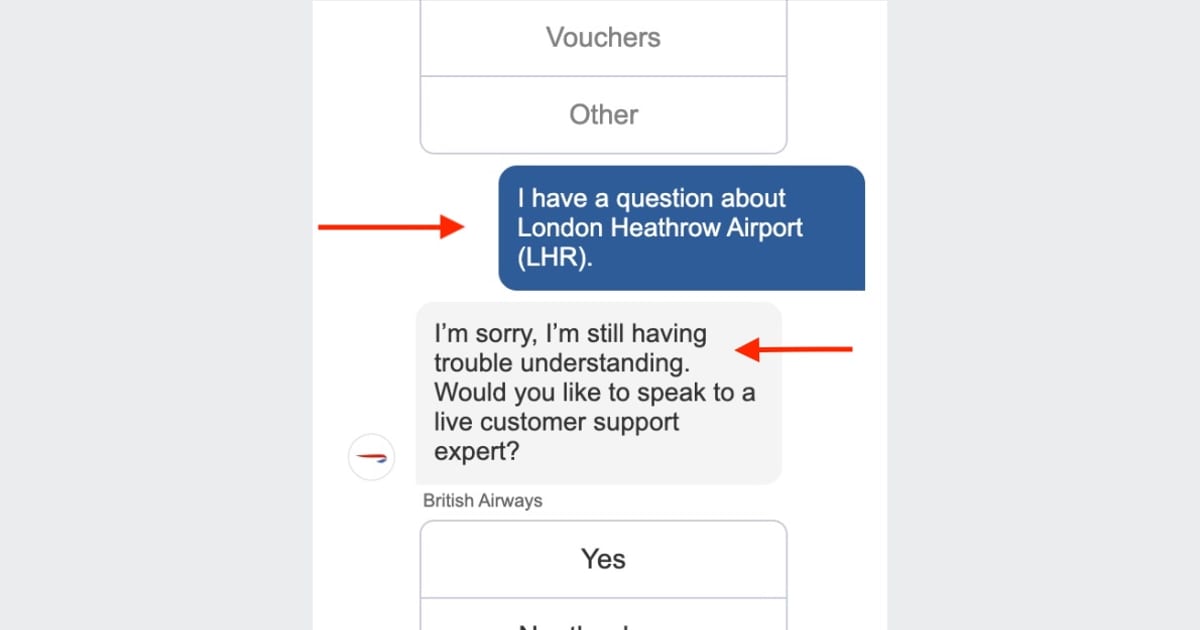Science fiction led us to believe robots would be flummoxed by trying to process logical paradoxes, such as the sentence “This statement is a lie” or perhaps the idea of “jumbo shrimp.”
But now that artificial intelligence has actually made its much ballyhooed emergence in everyday life, it turns out the machines can be stopped in their digital tracks with other sorts of brainteasers.
The British Airways customer service chatbot, for instance, evidently doesn’t understand complicated concepts such as “Heathrow” and “London,” where the airline has its main hub and headquarters, respectively.
A customer of the United Kingdom’s flag carrier has brought to light this embarrassing IT failure in a video posted to social media.
In the clip, creator Paddy Lennox scrolls through an online conversation conducted on his laptop with a British Airways AI-powered chatbot.
Trying to locate Lennox’s reservation, the bot asks the passenger, “Where are you flying from? Enter the city (for example London) or airport code (for example LHR).”
In the bubble with Lennox’s reply, we see he has typed “LHR,” the code for Heathrow Airport.
The bot responds, “I’m sorry, I don’t recognise this city or airport.”
Even though the bot had used LHR as an example precisely two lines above.
“Be sure to check the spelling and make sure it’s a place in which British Airways operates,” the bot advises.
So Lennox enters LHR again. Same response.
He then tries typing “London” a couple times, and both times the London-based British Airways reports that it does not recognize any such locale.
To mix things up a little, the bot could have at least pasted in that GIF of Mariah Carey saying “I don’t know her.”
Growing frustrated, Lennox then tries “Heathrow” with no success.
“It’s only your hub airport, you absolute goons,” Lennox says in the voiceover.
After trying one last time by entering “The capitol city of England, London,” the bot does the same this-does-not compute routine.
Replies Lennox: “Jesus, British Airways how do you not recognise LHR when you give LHR as the example????”
Replies the chatbot: “I’m sorry, I don’t recognise this city or airport.”
To make sure Lennox’s experience wasn’t a fluke, we went to the Help Centre at the British Airways website and started our own chat with a customer service bot.
We entered queries such as “I have a question about Heathrow,” “I have a question about London Heathrow Airport (LHR)” (see the screenshot at the top of this page), and “Does British Airways have flights to or from London?”
The bot was unable to answer any of them, replying, “I’m sorry, I’m still having trouble understanding. Would you like to speak to a live customer support expert?”
When we finally said yes to that option, the bot reported that we were 24th in line.

IT Problems at British Airways
The inadequate chatbot is far from the first technological shortcoming at British Airways.
In November, an IT outage grounded the carrier’s flights and temporarily took down its website and mobile app, causing widespread travel disruptions throughout the U.K. and Europe.
And still British Airways CEO Sean Doyle had the nerve to claim partial success, arguing that the airline’s £750 million investment in improving computer systems had kept the outage from dragging on for days as it would have in the past.
As aviation observer Mateusz Maszczynski points out, £100 million from the airline’s IT investment was supposed to go toward “machine learning, automation, and artificial intelligence” at British Airways.
“Hopefully, the chatbot didn’t take up too much of that budget,” Maszcynski writes.
AI’s Takeover of Customer Service
The issue of unhelpful AI bots isn’t limited to British Airways, either.
Frommer’s contributor William McGee has written about the unpeopled state of customer service in many aspects of travel, including airlines as well as hotel chains, car rental companies, and other businesses.
“For something as complicated, nerve-wracking, and critical as travel,” according to McGee, human-free technology systems often fall short of providing the sort of finesse that sentient human beings are capable of. Yet it’s getting increasingly difficult to find a human being to interact with.
See McGee’s Frommer’s commentary for some ideas on resisting the complete robot takeover of customer service before it’s too late.
And defend yourself better by checking out our helpful tips for spotting AI-generated reviews. The advice was written by an AI expert (a human one).
